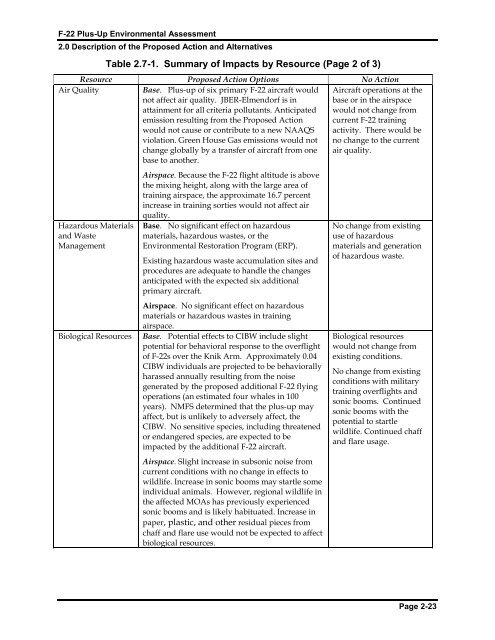F-22 Plus-Up Environmental Assessment - Joint Base Elmendorf ...
F-22 Plus-Up Environmental Assessment - Joint Base Elmendorf ...
F-22 Plus-Up Environmental Assessment - Joint Base Elmendorf ...
Create successful ePaper yourself
Turn your PDF publications into a flip-book with our unique Google optimized e-Paper software.
F-<strong>22</strong> <strong>Plus</strong>-<strong>Up</strong> <strong>Environmental</strong> <strong>Assessment</strong><br />
2.0 Description of the Proposed Action and Alternatives<br />
Table 2.7-1. Summary of Impacts by Resource (Page 2 of 3)<br />
Resource Proposed Action Options No Action<br />
Air Quality<br />
<strong>Base</strong>. <strong>Plus</strong>-up of six primary F-<strong>22</strong> aircraft would<br />
not affect air quality. JBER-<strong>Elmendorf</strong> is in<br />
attainment for all criteria pollutants. Anticipated<br />
emission resulting from the Proposed Action<br />
would not cause or contribute to a new NAAQS<br />
violation. Green House Gas emissions would not<br />
change globally by a transfer of aircraft from one<br />
base to another.<br />
Aircraft operations at the<br />
base or in the airspace<br />
would not change from<br />
current F-<strong>22</strong> training<br />
activity. There would be<br />
no change to the current<br />
air quality.<br />
Hazardous Materials<br />
and Waste<br />
Management<br />
Biological Resources<br />
Airspace. Because the F-<strong>22</strong> flight altitude is above<br />
the mixing height, along with the large area of<br />
training airspace, the approximate 16.7 percent<br />
increase in training sorties would not affect air<br />
quality.<br />
<strong>Base</strong>. No significant effect on hazardous<br />
materials, hazardous wastes, or the<br />
<strong>Environmental</strong> Restoration Program (ERP).<br />
Existing hazardous waste accumulation sites and<br />
procedures are adequate to handle the changes<br />
anticipated with the expected six additional<br />
primary aircraft.<br />
Airspace. No significant effect on hazardous<br />
materials or hazardous wastes in training<br />
airspace.<br />
<strong>Base</strong>. Potential effects to CIBW include slight<br />
potential for behavioral response to the overflight<br />
of F-<strong>22</strong>s over the Knik Arm. Approximately 0.04<br />
CIBW individuals are projected to be behaviorally<br />
harassed annually resulting from the noise<br />
generated by the proposed additional F-<strong>22</strong> flying<br />
operations (an estimated four whales in 100<br />
years). NMFS determined that the plus-up may<br />
affect, but is unlikely to adversely affect, the<br />
CIBW. No sensitive species, including threatened<br />
or endangered species, are expected to be<br />
impacted by the additional F-<strong>22</strong> aircraft.<br />
Airspace. Slight increase in subsonic noise from<br />
current conditions with no change in effects to<br />
wildlife. Increase in sonic booms may startle some<br />
individual animals. However, regional wildlife in<br />
the affected MOAs has previously experienced<br />
sonic booms and is likely habituated. Increase in<br />
paper, plastic, and other residual pieces from<br />
chaff and flare use would not be expected to affect<br />
biological resources.<br />
No change from existing<br />
use of hazardous<br />
materials and generation<br />
of hazardous waste.<br />
Biological resources<br />
would not change from<br />
existing conditions.<br />
No change from existing<br />
conditions with military<br />
training overflights and<br />
sonic booms. Continued<br />
sonic booms with the<br />
potential to startle<br />
wildlife. Continued chaff<br />
and flare usage.<br />
Page 2-23
















